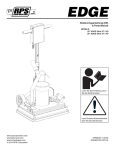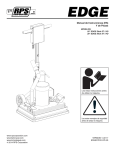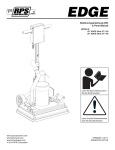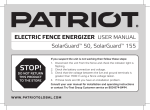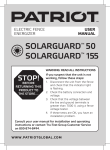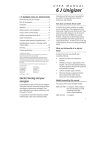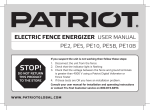Download +1 - Patriot Electric Fence Chargers
Transcript
+1*=.'.1.9> )*8.,3 ;&1:* *QJHYWNH+JSHJ 5WTIZHY7JXTZWHJ,ZNIJ & 5&97.49 INTELLIGENT FENCING FOR THE COUNTRY \\\UFYNTYLQTGFQHTR (TSYWTQ<MJS>TZ3JJI.Y <MJWJ[JW9MJ9WFNQ2F^9FPJ>TZ Checking voice mail, responding to e-mail, sitting in meetings, closing business deals, and returning calls on your cell phone while stuck in traffic during the morning commute. This is your life, Monday thru Friday – and you thrive in it. Your strong desire for success shows in your career and devotion to your family. The same can be said about your passion for life out of the office. You enjoy the peace and tranquility of living away from the city, the radiant view of an evening sunset, cattle grazing in the pasture, taking leisurely horseback rides, and having a few head of livestock you can call your own. You take pride in this. Patriot brand electric fence chargers and accessories are built on the foundation of providing you the flexibility to enjoy your lifestyle with a sleek design that matches your need for simplicity, reliability, and performance – all at an outstanding value. As you read through the Patriot Electric Fence Product & Resource Guide, you will see the results of nearly 70 years of experience from one of the world’s leading electric fence manufacturers. You will see our commitment to research and product innovation – such as chargers that can operate on both a 110V power plug and a 12V battery. You will see our dedication to providing you with the knowledge, tools and support to help you build the best electric fence and understand why we say Patriot is Intelligent Fencing for the Country. Whether you have cattle, horses, sheep, goats, or other type of livestock, Patriot gives you the peace of mind of knowing your animals are safe so that you can enjoy the lifestyle you have worked so hard to achieve. <M^*QJHYWNH+JSHJ$ An electric fence charger takes electric energy from a power source and delivers it to a fence as pulses. These pulses are commonly referred to as the “shock” felt by any animal which touches an electrified fence. Unlike a conventional fence, an electric fence is a psychological barrier such that animals learn to respect the fence. (TSYJSYX 5WTIZHYX Fence Chargers . . . . . . . . . . . . . . . . . . . . . . . . . . 2-3 The benefits of an electric fence include: • Low cost – requires less labor and material than conventional barb or woven wire fences. • Relatively simple and easy to construct. • Long life – good, permanent fences can last nearly 30 years. • Safer and better livestock protection. • Flexibility – wire spacing and fence design can be modified to control a variety of animals. • Portable – can be moved quickly and easily. • Discourages trespassers and predators. • Environmentally-friendly – low cost, portable barriers can protect trees and waterways Fence Accessories . . . . . . . . . . . . . . . . . . . . . . . . 4-7 7JXTZWHJX Fence Planning. . . . . . . . . . . . . . . . . . . . . . . . . . 8-9 Permanent Fence . . . . . . . . . . . . . . . . . . . . . . 10-11 Temporary Fence . . . . . . . . . . . . . . . . . . . . . . . 12-13 Grounding & Testing . . . . . . . . . . . . . . . . . . . . 14-15 Troubleshooting . . . . . . . . . . . . . . . . . . . . . . . . . . . 16 Terminology & Tips . . . . . . . . . . . . . . . . . . . . . . . . 17 +JSHJ(MFWLJWX Unique, Industry-Leading Dual-Purpose Feature Allows Chargers to Run on 110V Plug or 12V Battery Ideal unit for smaller applications, strip-grazing and portable fences. Charger Item Power Type Output Energy Stored Energy Range1 Current Consumption Recommended Solar Panel2 Livestock Control Warranty (includes damage from lightning) Great choice for fencing small numbers of livestock. 5 5 803401 803402 Dual-Purpose (110V Plug and Battery) Dual-Purpose (110V Plug and Battery) Advanced Low Impedance Advanced Low Impedance 0.5J 1.0J 0.7J 1.3J 15 miles / 60 acres 30 miles / 100 acres 45 mA 90 mA 10 watt 10 watt All All 12 month - full replacement 12 month - full replacement Notes : 1. Actual range depends on many factors including fence and farm conditions. 2. Depending on geographic location, a larger panel (or additional panels) may be required to achieve optimal results. \\\UFYNTYLQTGFQHTR Greater range for more acres and more livestock. Most powerful charger in the lineup with the greatest range and livestock control. Powerful integrated solar charger is a top choice for remote areas. Mounts directly on a T-post and can operate up to 21 days without sunlight. 5 5 58 803403 805153 803374 Dual-Purpose (110V Plug and Battery) Dual-Purpose (110V Plug and Battery) Solar (Internal Rechargeable 12V Battery) Advanced Low Impedance Advanced Low Impedance Advanced Low Impedance 2.0J 3.0J 0.15J 2.7J 4.6J 0.2J 50 miles / 200 acres 65 miles / 260 acres 10 miles / 40 acres 170 mA 300 mA less than 20 mA 20 watt 40 watt ––– All All All 12 month - full replacement 12 month - full replacement 12 month - key parts are repairable/replaceable Item: 804129 Replacement battery leads for P5, P10, P20 and P30 Chargers. 5 7 4 ) : ( 9 8 Item: 807396 Replacement power cord for P5, P10, P20 and P30 Chargers +JSHJ&HHJXXTWNJX )ZFQ5ZWUTXJ 5NSQTHP.SXZQFYTW Item: 809980 • For use on wood posts or T-posts • Works with high-tensile wire, poliwire, or politape in both permanent and temporary fences • 5-year warranty, black, 25 per bag 7NSL.SXZQFYTW Item: 810840 • Screw-in insulator for with wood posts • Works with high-tensile wire, poliwire, or politape in both permanent and temporary fences • 5-year warranty, black, 25 per bag ¶95TXY *]YJSIJW Item: 810841 • Reversible – fits on both sides of T-posts • Solid construction for longevity and superior holding capacity – won’t slip or fall off • Works with high-tensile wire, poliwire, or politape in both permanent and temporary fences • Great way to add high-tensile wire to existing barb wire fence • 5-year warranty, black, 10 per bag 95TXY5NSQTHP.SXZQFYTW Item: 811412 • Use with standard T-posts for high-tensile wire or poliwire in both permanent and temporary fences • Pinlock allows for easy wire removal • 5-year warranty, black, 25 per bag ¶+NS9ZGJ.SXZQFYTW Item: 811411 • Use on wood posts with staples to insulate wire • Works with high-tensile wire in permanent fences • 5 year warranty, black, 100 per bag \\\UFYNTYLQTGFQHTR <TTI5TXY (QF\.SXZQFYTW Item: 810507 • Large shield to prevent arcing, easily attaches to wood post with nails or screws • Works with high-tensile wire, poliwire, or politape in both permanent and temporary fences • 5-year warranty, black, 25 per bag ¶<TTI5TXY*]YJSIJW Item: 810843 • Great way to add high-tensile wire to existing barb wire fences on wood posts • Works with high-tensile wire, poliwire, or politape in both permanent and temporary fences • 5-year warranty, black, 10 per bag *SI8YWFNS.SXZQFYTW Item: 809981 • Long leakage paths to prevent arcing and deep grooves to hold wire in place • Use with high-tensile wire and poliwire in permanent fences for ends, curves, and corners • 5-year warranty, black, 10 per bag .S1NSJ8YWFNSJW Item: 809800 • Use with high-tensile wire in permanent fences to maintain fence line tension • Resists corrosion • 1-year warranty, 5 per bag (includes locking pins) (ZY4ZY8\NYHM Item: 809696 • Use to turn fence line on/off • Stainless steel fittings for positive non-corrosive contact and fully sealed from insects and weather • 1-year warranty, black 8UWNSL(QNU8YWFNSJW Item: 809813 • Use with high-tensile wire in permanent fences to maintain tension along fence line or on brace wires • Solid steel and aluminum construction with unique smooth spring clip design • 1-year warranty 7TI5TXY.SXZQFYTW 1NLMYSNSL&WWJXYTW Item: 809979 • Fits rod posts from 1/4” to 5/8” • Works with high-tensile wire, poliwire, or politape in both permanent and temporary fences • 5-year warranty, black, 25 per bag Item: 810837 • Helps to protect fence charger in the event of lightning strike to the fence line • Strong porcelain frame with steel connection points 5 7 4 ) : ( 9 8 +JSHJ&HHJXXTWNJX /TNSY(QFRUX Item: 809984 • Split-bolt clamp design used to hold multiple fence wires or underground cable • Solid zinc construction recommended for all permanent fence line connections • 1-year warranty, bag of 5 +JSHJ7JJQ :SIJWLWTZSI(FGQJ Item: 809731 • Double insulated with 12.5 gauge galvanized wire • Use underneath gates to maintain charge, as a leadout wire, to connect fence wires in all live ground systems, and to connect charger to fence line • 1-year warranty, black, 50’ roll Item: 809711 • Rugged frame can hold up to 660’ of politape or 1650’ of poliwire • Special hook allows reel to rest on fence wire for use in temporary fences • 1-year warranty on reel, 5-year UV guarantee on bobbin 5TQN\NWJ • Great choice for temporary fences with plastic tread-in or pigtail tread-in posts • 6 stainless steel conductors and UV stabilized yarn • Available in two lengths: 660’ white (Item 809759), 1650’ white (Item 809760) • 1-year warranty 5TQNYFUJ • Great choice (with higher visibility than poliwire) for temporary fences with plastic tread-in or pigtail tread-in posts • 6 stainless steel conductors and UV stabilized yarn • Available in two lengths: 660’ white (Item 809776), 1320’ white (Item 809764) • 1-year warranty \\\UFYNTYLQTGFQHTR >JQQT\,FYJ -FSIQJ Item: 809814 • Fully insulated handle with positive non-slip grip and high tensile galvanized spring • Works with high tensile wire, poliwire, politape, or as a replacement handle for Patriot Spring Gate (Item 809983) in permanent and temporary fences • 1-year warranty 3T0NHP-FSIQJ Item: 810838 • Fully insulated, durable plastic handle can also be used to safely hold electrified wires • Works with high tensile wire, poliwire, or politape in permanent and temporary fences • 1-year warranty, yellow 5NLYFNQ9WJFI.S5TXY Item: 810842 • Easy to move, steel step-in post with large foot and insulated top for use with poliwire and politape • Measures 41” in total height (34” height above ground) • 1-year warranty )NLNYFQ;TQYRJYJW Item: 806217 • Essential tool for accurate testing of fence and ground systems • Readings from 200V to 9,900V • Solid state circuitry designed for durability and rugged use • 1 year warranty, case, easy-to-read instructions 8UWNSL,FYJ Item: 809983 • Use as gate in temporary and permanent fences • Covers up to 16’ gate opening • Includes: Yellow gate handle, activator, anchor, and 16’ spring • 1-year warranty +JSHJ&QJWY Item: 804565 • Light flashes if fence voltage is too low or loss of power (can be seen up to 1 mile away) • Clips on fence wire, poliwire, or politape • Replaceable lithium battery can go up to 5 years on standby or 2 weeks of continuous flashing • 1 year warranty, just clip on and turn on 5QFXYNH9WJFI.S5TXY Item: 809730 • High strength post with long galvanized pin and multiple places for poliwire and politape • For use in temporary fences • 1-year warranty, white ¶<WFU &WTZSI .SXZQFYTW Item: 811413 • Place around corner/end posts to insulate wire • Works with high-tensile wire in permanent fences • 5 year warranty, black, 10 per bag 5 7 4 ) : ( 9 8 +JSHJ5QFSSNSL 89*5 9^UJTK*QJHYWNH+JSHJ Ask yourself this, “Do I need a permanent electric fence or a temporary electric fence?” Permanent Temporary Fence Life Long (up to 30 years) Short (less than 3 years) Ease of Installation Some knowledge, special tools required Simple and fast Unlimited Few acres or miles of fence All Some limitations Few times a year Few times a month No Yes Distance/ Area Livestock Controlled Routine Maintenance Easy to Move 89*5 8JQJHY>TZW&HHJXXTWNJX 89*5 Now that you have selected your charger, you need to determine how you are going to build your fence. Are you going to use wood posts, steel posts, rod posts, etc.? Or is it just a temporary fence with tread-in posts? What type of gate(s) do you plan on using? Thankfully, there’s a good assortment of Patriot accessories to fit most all of your electric fence needs. Please review the next pages about permanent and temporary electric fences to help determine which Patriot accessories will work best for you. 5QFSYMJ1F^TZY 89*5 Sketch a diagram and measure the distance of the area you would like to fence. Make note of any unique features along the proposed fence line (i.e., hills, waterways, trees, roadways, etc.) as well as where you intend to have a gate(s). If necessary, it is also a good idea to have your utility company mark any underground cables/lines that may be in the immediate vicinity. ,WTZSINSL9JXYNSL 89*5 8JQJHY>TZW(MFWLJW How will you power your charger – 110 volt plug, 12 volt battery, or solar? The Patriot P5, P10, P20 and P30 chargers provide the unique option of operating from either a 110 volt plug or 12 volt battery. If you prefer a totally integrated solar unit, the Patriot PS15 is your best choice. When comparing chargers, make sure you compare them on the basis of their rated output energy as that is the amount of energy delivered to the fence. Some chargers will only list a stored energy rating. As the name implies, stored energy is just the amount of energy stored inside the charger. However, it does not relate to the amount of energy delivered to the fence. (Patriot chargers show both an output and stored rating to give you a complete picture of the charger’s power.) \\\UFYNTYLQTGFQHTR This is one of the most important parts of the fence. Without a proper ground system, your will not be able to achieve the maximum benefits of your electric fence. Please refer to the Grounding & Testing section of this guide (pages 14-15) for more information on how to properly install and test a good ground system. 4YMJW9MNSLXYT(TSXNIJWNSYMJ5QFSSNSL5WTHJXX (TS[JWYNSLF'FWG<NWJTW<T[JS <NWJ+JSHJ Do you already have a good barb wire or woven wire fence, but want to make it electric? refer to your charger’s user manual for specific installation instructions and always mount the charger where it is out of reach of children and animals. (FS.:XJ2TWJYMFS4SJ(MFWLJW$ (Note: You should never try to electrify the existing barb or woven wire as it is too dangerous for your livestock and not very effective.) Yes, you can use more than one charger, but each charger must be on a separate fence system. NEVER connect more than one charger to the SAME FENCE. Patriot T-Post Extenders (810841), as shown in the pictures above, and Wood Post Extenders (810843) allow you to maintain your current fence structure while adding hightensile wire to make it electric. This is a much safer and more highly effective way for an electric fence. <MFY9^UJTK<NWJ8MTZQI.:XJKTW YMJ+JSHJ1NSJ$ <MJWJ8MTZQI>TZ.SXYFQQ>TZW(MFWLJW$ If you plan to use a 110 volt plug to power your charger, it should be placed inside a barn or shed near the power source. If you plan on using a 12 volt battery, the charger can be placed outside. Because of the weather-resistant case and built-in clip-on-wire feature, the Patriot P5, P10, P20 and P30 chargers can be attached directly to the fence wire. If you are using the Patriot PS15, it too has a weatherresistant case, can be mounted on a standard t-post, and is most effective if placed along the middle of the fence with the panel facing towards the South. In all cases, The best permanent electric fences are constructed using 12.5 gauge galvanized high tensile wire. It provides a lower level of resistance than a smaller gauge of wire and has sufficient capacity to carry the electrical current of the fence. Some people use a smaller gauge galvanized wire (i.e., 14 ga., 16 ga., etc.); however, these have higher levels of resistance, do not allow you to achieve the maximum benefits of your charger, and your fence life may not be as long. (Aluminum wire is not the same as steel galvanized wire. Small aluminum wire also has less resistance than comparable size steel wire.) For temporary fences, good poliwire or politape with at least 6 strands of conductors are the best choice.” 7 * 8 4 : 7 ( * 8 5JWRFSJSY+JSHJ A permanent electric fence is a great choice that, if built properly, can last for nearly 30 years with only limited, routine maintenance. It is the most common type of electric fence and works exceptionally well to contain all types of livestock and keep out most all predators. (TWSJW*SI'WFHJX <NWJ8UFHNSL Corner and end braces are most commonly made of wood posts with a metal pipe between them. (You can also use metal pipe posts instead of wood posts.) The braces are made of at least two posts spaced at least 10 feet apart or 2.5 times the height of the finished fence. These H braces serve as the foundation of the fence line and help to maintain the tension. For more information on brace construction, please consult your local Patriot dealer or a fence construction company. Most permanent electric fences have between 2 – 6 wires. Cattle and horses can generally get by with 2 or 3 wires, while sheep and goats should have at least 5 or 6 wires. To maintain the best control, you must maintain proper spacing between each wire. Below are some samples (additional wire spacing diagrams can be found on the Patriot web site): 10 m (33’) +JSHJ5TXYX Item 450 mm (18”) Live 450 mm (18”) Type of Post Wood T Rod Dual-Purpose Pinlock 809980 Ring 810840 T-Post Pinlock 811412 4” Fin Tube 811411 6” T-Post Extender 810841 Wood Post Claw 810507 6” Wood Post Extender 810843 Rod Post 809979 Wire Spacing for Cattle & Horses 10 m (33’) Live 230 mm (9”) 900 mm (3’) Insulator Live 900 mm (3’) Permanent electric fences can be adequately constructed with wood posts, t-posts, or rod posts. Typically the type of post chosen is determined by local availability and price. Based on your post type, here are the Patriot insulators you should consider: Live 200 mm (8”) Live 180 mm (7”) 150 mm (6”) 150 mm (6”) Wire Spacing for Sheep & Goats \\\UFYNTYLQTGFQHTR Live Live Patriot Charger Ground Rods (Not drawn to scale. Ground rods should be at least 10 feet apart.) Wrap Around Insulator* Underground Cable Joint Clamp Insulator* Fin Tube Insulator* End-Strain Insulator* Cut-Out Switch (Wood Post / T-Post / Rod Post) In Line Strainer Spring Clip Strainer FenceAlert FENCE POSTS FENCE POST H-Brace with wood posts and metal pipe (Metal pipe can be used instead of wood posts) Along Fence Line (Can be wood or steel) * NOTE About Insulators - Wrap Arounds / End-Strainers and Pinlocks/Claws/Fin Tubes can be used on the entire fence or mixed depending on individual needs and post type. Permanent Electric Fence Checklist H brace for the start of a 5-wire fence Fence Layout Diagram Patriot Charger Posts Insulators 12.5 ga. Galvanized High-Tensile Wire End-Strain Insulators Ground Rod(s) & Ground Clamp(s) Underground Cable Cut-Out Switch(s) Joint Clamps Spring Clip / In-Line Strainers Lightning Arrestor Digital Voltmeter Fence Alert Spring Gate / Gate Handle (optional) Wrap Around Insulator (optional) 7 * 8 4 : 7 ( * 8 Tools Needed Wood post along the line of a 5-wire fence T-Post along the line of a 5-wire fence Spinning Jenny Fence Pliers Crimps & Crimp Tool Hammer / Drill / Screwdriver Screws/Nails/Fence Staples The number of each item you need depends on the overall length of fence, number of posts, number of wires, and your management style. (For example, for a 5-wire fence, you will need 5 insulators per post. For a P20 charger you will need at least 3 ground rods and ground clamps.) Depending on whether you are building the fence, or a fence contractor, you may not need all of the tools mentioned in the checklist. 9JRUTWFW^+JSHJ A temporary electric fence works well for maintaining a small number of livestock for relatively short period of time. The fence can be quickly constructed and moved as often as needed. Temporary electric fences are terrific choices for cattle and horses. They are sufficient for sheep and goats, but require more work and greater attention to detail (i.e., wire spacing, available posts, line tension, etc.). Temporary electric fences are also excellent for overnight trail rides to control horses and on camping trips to keep unwanted animals away from your camp site. +JSHJ5TXYX +JSHJ<NWJ Temporary electric fences are generally constructed with either pigtail tread-in posts or heavy-duty plastic tread -in post. Below is a brief list of the differences: While permanent electric fences are constructed with 12.5 gauge high-tensile wire, temporary electric fences are constructed with Poliwire (809759 – 660’ roll, 809760 – 1650’ roll) or Politape (809776 – 660’ roll, 809764 – 1320’ roll). Both contain 6 stainless steel conductors and UV stabilized yarn. Plus, they are white. The biggest difference is that Politape is larger and therefore more visible than Poliwire. As a result, Politape is the preferred choice for horses. Item Number Maximum Lines of Standard Poliwire or Politape Step-In Foot Post Can be used with cattle & horses Can be used with sheep & goats Pigtail Tread-In Heavy-Duty Plastic Trend-In 810842 809730 1 8 Temporary Electric Fence Checklist Steel, steel spike Plastic, steel spike Fence Layout Diagram Steel, insulated top sleeve Plastic Patriot Charger Pigtail / Plastic Tread-In Posts Yes Yes Poliwire / Politape Fence Reel No Yes Digital Voltmeter Fence Alert Gate Handle / No-Kick Handle -T\)T>TZ/TNS5TQN\NWJTW5TQNYFUJ$ To join broken (or separate ends) of poliwire or politape, use a cigarette lighter to burn away the plastic yarn in order to expose the stainless steel wires. Twist and join the wires together, then tie the poliwire or politape in a knot. The electrical current can then pass through wires. Tools Needed Pliers / Wire Cutters / Pocketknife The number of each item you need depends on the overall length of fence, number of wires, and your management style. (FSF9JRUTWFW^+JSHJGJ:XJIFXF 'TZSIFW^+JSHJ$ No, a temporary fence is not suitable for a boundary fence. A permanent fence is a much better choice. \\\UFYNTYLQTGFQHTR Patriot PS15 Solar Charger Poliwire or Politape Mounted on Post (Can use P5, P10, P20 or P30 Charger with 12V battery) FenceAlert Fence Reel FENCE POST No-Kick Handle or Yellow Gate Handle Pigtail Tread-In (This post may be permanent or temporary) Plastic Tread-In FENCE POST (This post may be permanent or temporary) 7 * 8 4 : 7 ( * 8 The pictures above show a section of a temporary fence using Pigtail Tread-In Posts (810842) and Politape (809776/809764). Section of temporary fence using the Plastic Tread-In Post (809730) and Poliwire (809759/809760). This picture shows a Fence Reel (809711) with a roll of Politape. Fence reels are great items to use in temporary fences to help maintain tension and keep Poliwire and Politape from getting tangled when moving the fence. ,WTZSINSL9JXYNSL Charger Ground All Live Ground return Charger Live Ground Ground Ground return <MFYNXF,WTZSINSL8^XYJR$ A grounding system is the most important component of any electric fence system. If an electric fence is not properly grounded, it will be much less effective. -T\ITJX,WTZSINSL<TWP$ For an electric fence to give an animal an electric shock, electrons must complete a circuit. Electrons travel from the charger, along the wires, through the animal’s body, through the soil to the grounding system, then back up to the charger. The grounding system consists of a number of ground rods (ground stakes) that absorb electrons in the soil. The larger the charger and the longer the fence line, the more ground rods are required. <MFY+FHYTWX\NQQ&KKJHYYMJ ,WTZSI8^XYJR$ Dry, sandy and non-conductive soil types allow electrons to spread out without being absorbed by the ground rods. If you have soil that is not well suited to grounding, use additional ground rods, choose a better location for the ground system, or use an alternate method of grounding. Vegetation touching the live fence wires allows electrons \\\UFYNTYLQTGFQHTR Ground Wire Return to leak, causing the fence to “short” and voltage to drop. Check the fence regularly to make sure that long grass and overhanging branches are not touching the live fence wire. Using a mixture of metals in the ground system will lead to electrolysis. This may cause the parts of the ground system to disintegrate in a short period of time. For example, never use copper wire with galvanized ground rods. ,WTZSI8^XYJRX³&QQ1N[J An all live ground system is recommended where soil is conductive (most moist soils are conductive). When an animal standing on the soil touches the fence, the circuit is completed and the animal gets a shock. ,WTZSI8^XYJRX³,WTZSI<NWJ7JYZWS A ground wire return system is recommended where soil is not conductive (most dry or sandy soils are not conductive). The fence is constructed using both live and ground wires. When an animal touches a live and a ground wire at the same time, the circuit is completed and the animal gets a shock. Charger Live Live Ground Testing the Ground System 8JQJHYNSLF8NYJKTWYMJ,WTZSI8^XYJR A suitable place for the ground system is: • At least 30’ away from any other ground system (i.e., telephone, house power line, etc.). • Away from livestock or other traffic that could interfere with the installation. • Where the system can easily be accessed for maintenance. • Ideally, where there is damp soil all year round (i.e., a shaded area or under the drip line of a building). NOTE: If it is not possible to locate the ground system in close proximity to the energizer, you may be able to use the existing fence line to connect to a remote ground system. In dry weather, it may be necessary to water the ground system in order to improve soil conductivity. ,WTZSI7TIX The number of ground rods depends on the type of charger being used to power the fence. Refer to information supplied with your charger for more information about the correct number of ground rods to use. To insert the ground rods: 1. Space the required number of 6’ ground rods at least 10’ apart. 2. Drive 6’ ground rods deeply into the soil, at least 10’ apart. Make sure that the ground rods protrude out of the soil at least 3” so they can be easily connected. 3. Join the ground rods in a series using joint clamps (or ground clamps) and insulated cable. 9JXYNSLYMJ,WTZSI8^XYJR 1. Turn off the charger. 2. At least 330’ away from the charger, heavily short circuit the fence by laying several steel rods (or lengths of pipe) against the fence. In dry or sandy soils, drive the rods up to 12” into the soil. 3. Turn on the charger. 4. Use a digital voltmeter to measure the fence voltage. It should read 2 kV or less. If not, put more steel rods against the fence. 5. To check the ground system, insert the voltmeter’s ground probe into the soil at the full extent of the lead and attach the clip to the last ground rod. The voltmeter reading should be no more than 0.3 kV. If the reading is higher than this, the ground system is insufficient. See the grounding checklist, add more ground rods, or find a better location for your ground system. ,WTZSINSL(MJHPQNXY Check your ground system to make sure: • All wires are joined securely. • Connections to ground rods are secure. • Ground rods are at least 6’ long and at least 10’ apart. • There are a sufficient number of ground rods. • All parts of the ground system are made of the same metal. • Ground rods are buried deeply in the soil. 7 * 8 4 : 7 ( * 8 9WTZGQJXMTTYNSL Faults (shorts) in the fence can reduce its effectiveness and may also cause other problems, such as interference on telephone lines or internal connections. Causes for faults may include: vegetation touching the live wires, broken wires or insulators, poor grounding, corroded metals in the fence line, poor connections, poor insulation, etc. Checking your fence regularly using a Patriot Digital Voltmeter (806217) is important in order to maintain an effective, problem-free electric fence installation. 9NU When using the digital voltmeter to find faults, isolate sections of the fence line with Patriot cut-out switches (809696). +NSINSLF+FZQY:XNSLYMJ5FYWNTY )NLNYFQ;TQYRJYJW Electrical current flows toward a fault (short) in the same way that water flows towards the plug-hole in a bath tub. A digital voltmeter allows you to follow the direction of the current towards the fault. 1. Check the charger and the ground system. 2. At the first cut-out switch, disconnect the rest of the fence and take a voltage reading. The voltage should be normal. 3. Move along the fence line disconnecting a section of the fence and taking a voltage reading at each cut-out switch. A fault will show an abnormally high reading. 4. If you are still having trouble, follow the troubleshooting flow chart below. Is the voltage reading at the charger normal? No Yes Test the voltage reading at the ground system On other occasions, has the voltage reading been higher? Yes No Charger is inadequate to power the fence. Try a more powerful charger. Yes Has the fence line been extended? Is the voltage reading less than 0.3 kV? Yes No No Look for: - Problems with leadout - Poor wire joins - Faulty insulation - Faults (shorts) on the fence - Vegetation touching the fence Examine the ground system. It may be faulty or inadequate. Fix fault \\\UFYNTYLQTGFQHTR +JSHJ9JWRNSTQTL^ AC – alternating current, mains power supply 110 – 120 V or 220 – 240 V. Leadout Wire – section of underground cable or wire that carries the electrical current from the charger to the fence. Amp – unit of current. Live – the current-carrying wire connected to the charger fence output terminal. Capacitors – used to store energy in the charger. Ohm – unit of resistance. Current – duration and magnitude of current causes the shock of the electric fence. Increasing the voltage increases current, while increasing resistance decreases current. DC – direct current, battery power supply (i.e., 12 V battery input). Output Energy – effective energy delivered by the charger. Pulse – brief electrical current given by a charger, approximately 0.0003 seconds per pulse. Resistance – loss of power and voltage on the fence. Fault / Short – energy loss from the fence (i.e., live wire lying on the ground, vegetation growing over the fence, etc. Ground – the rod(s) in the ground connected to the ground terminal on the charger. Joule – unit of energy. One joule is one watt of power for one second. Stored Energy – energy accumulated in the storage capacitor(s) in between output pulses. Watt – unit of power. One watt is one joule per second. Volt / Voltage – unit of electrical pressure causing current to flow. Sometimes it is stated as “kV” or kilovolts which is equal to 1000 volts. 9NUX <NWJ9JSXNTS &SNRFQ9WFNSNSL Electric fencing provides a psychological barrier rather than a physical one, so there is no need to excessively tension wire. Heavy strainer assemblies are not required either, reducing the overall cost of construction. Electric fence wire should be tensioned to 200 lb. By comparison, conventional fence wire should be tensioned to 340 lb. The tension of each wire can be measured using a tension meter. To train animals to respect electric fencing, one method is to use a small, well-fenced holding paddock. Divide the holding paddock using your Patriot charger and Politape. Introduce the untrained livestock to the paddock. The animals will quickly learn to avoid the electric fence barrier. 2N]NSL2JYFQX 7+.7FINT+WJVZJSH^.SYJWKJWJSHJ Many farms suffer from RFI. This often results in poor radio reception and an annoying ticking noise on the telephone line. Patriot chargers are fitted with special components and advanced circuitry that significantly reduces the levels of electrical emissions that might otherwise affect adjacent electrical equipment. Avoid using different metals in your electric fence. In damp conditions, when an electric current passes through the differing metals, electrolysis will occur. For example, using stainless steel ground rods and aluminum leadout wire will cause problems. In a short space of time, the aluminum will disintegrate. If possible, keep the wire joints above the soil to improve airflow and reduce electrolysis. Seal the wire joints with thick paint, epoxy or tar to keep moisture away from the joint area. Using identical metals in your electric fence will avoid problems with electrolysis altogether. 7 * 8 4 : 7 ( * 8 9WZ9JXY.SH 528 Grant Road, Mineral Wells, Texas 76067, USA Toll Free 1.800.874.8494 | P: 940.327.8020 | F: 940.327.8048 \\\UFYNTYLQTGFQHTR Although the information presented in this product catalog is believed to be accurate and reliable, no responsibility for inaccuracies can be assumed by Tru-Test. Performance data is typical only and variations due to component manufacturing tolerances are normal. Tru-Test reserves the right at any time to change performance characteristics or specifications without prior notice. ©Tru-Test, Ltd., Tru-Test, Inc. 2007. All rights reserved. (07/07)




















